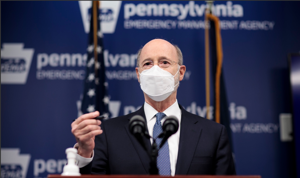Pennsylvania governor frames charter school reforms as better for taxpayers

(The Center Square) – Pennsylvania Gov. Tom Wolf said Friday that cutting funding and increasing accountability for underperforming charter schools makes better use of taxpayer dollars than the current system.
“If we don’t fix the problems in our charter schools now, we are setting our children up for failure and that’s unacceptable,” Wolf said during a news conference. “We are also charging our taxpayers too much and that’s unacceptable. Both of these are unacceptable.”
But school choice groups say the repackaged messaging doesn’t change the fact that districts don’t undergo the same level of scrutiny or face funding cuts for poor student performance.
“Pennsylvania families across the Commonwealth are enjoying their lawful rights to enrolling their children in public charter schools,” said Lenny McAllister, CEO of the Pennsylvania Coalition of Public Charter Schools. “The General Assembly created charter schools 24 years ago to be a public alternative to school districts for families who couldn’t afford the educational choices available to those with the resources to pay for it. The governor wants to slash funding and limit these options for our state’s neediest families to benefit his political allies.”
The governor joined Sen. Lindsey Williams, D-Pittsburgh, Rep. Joe Ciresi, D-Royersford, and educational leaders from across the state to stump for a forthcoming bill that standardizes charter school tuition rates and adds accountability provisions to give local districts a clearer view of how the funding gets spent.
“We have some great charter schools are out there,” Ciresi said. “This isn’t about that. This is about giving local control back. … This bill makes sure every student has everything they need and taxpayers are protected.”
Under current law, school districts pay a per-student tuition rate for each child that attends a charter school. In 2020, that amount totaled $2.1 billion and will increase by $400 million this year alone.
“The way the law is set up, we can’t guarantee that every charter school is giving every student the opportunity they need to get,” Wolf said. “The problem is more important right now than ever.”
Critics say that charters get overpaid because they lack some of the fixed costs of maintaining physical locations. School board leaders also argue that charter school boards escape public oversight while taking taxpayer dollars because their members are appointed, not elected. This leaves critical gaps in oversight that allow problematic schools to stay operational.
“These problems are impacting students and taxpayers, and they boil down to funding, accountability and oversight,” State College Area School District Superintendent Robert O’Donnell said. “Not one charter school in our region has a career and technical center for their students, but are funded as if they do. … They don’t have the same building and grounds costs as traditional schools, and yet they receive funding as if they do.”
The Commonwealth Foundation, a free-market focused advocacy organization, said because tuition rates subtract certain costs upfront – including transportation, facilities and debt services – charter schools receive about 27% less per student than the district does. Michael Torres, a foundation spokesperson, said although the charter school law needs updating, he’s critical of the “hyperbolic situation” presented by the governor.
But the proposed reforms don’t stop there. The governor also wants to change the way special education funding flows to charters. Current law assumes that 16% of charter students receive special education services, a notion that is “outdated” and skews the tuition rate districts must pay.
Instead, Wolf proposes limiting cyber tuition to a flat per student rate of $9,500 and funneling all special education dollars through an updated formula – a provision not applied to traditional districts.
Ciresi estimates that the funding changes would save the Philadelphia School District – where half of the state’s 170,000 charter students live – up to $64 million each year. In Pittsburgh, the district would recoup $11 million. Erie and Allentown would see tuition savings of 2.5 million and 3 million each, while the Coatesville Area School District would net $14 million.
But charter school groups said the proposal will gut $229 million from their schools, including a $99 million cut to special education funding alone.
“I would like to stress how devastating any funding cuts would be for our children, especially in Philadelphia where the governor’s plan would slash special education funding by half for our students,” said Dr. Stacy Gill-Phillips, CEO of the West Philadelphia Achievement Charter Elementary School. “Philadelphia public charter schools, which operate on an extremely tight budget, have been leading the effort in our city to get students back in the classroom and any cut in resources would derail this progress.”
PCPCS points out that 70% of charter students are nonwhite and 65% are economically disadvantaged. This makes the proposed cuts all the more troubling, said Dr. Dara Ware Allen, CEO of City Charter High School.
“Public charter schools serve a diverse population of students,” she said. “Many of them are some of Pennsylvania’s most vulnerable children who deserve our investment and support.”
Recognizing that high quality options exist in both charter schools and traditional districts “should be a bipartisan stance,” she said, something the governor’s proposal doesn’t do.
“We need all hands on deck helping student succeed in these unprecedented times and beyond,” she said.
While the governor’s support for charter school reform isn’t new, critics of the existing law said the pandemic has illuminated the cost of virtual education and, they say, cyber charters charge too much.
“It [costs] about $5,000 to educate and $13,000 to $25,000 is walking out the door,” said Donna Smith, a member of the Bellefonte Area School Board. “So it’s really a struggle for us.”
The issue compounded last spring and summer as enrollment at cyber charter schools soared amid the onset of the pandemic. Dr. Rich Jensen, CEO of Agora Cyber Charter School, said the state’s 14 virtual institutions welcomed 25,000 new students last year alone. He accused the governor of prioritizing district leaders over the demonstrated preference of thousands of students.
“The governor is not worried about what is best for Pennsylvania students, he is too busy listening to concerned school district leaders who are seeing their students seek options elsewhere,” he said.
Williams said the standardized tuition rate was calculated by taking the cost-per-student for the state’s top five performing charters and selecting the lowest rate among them. Still, some districts argued it was too high while some charter schools said it was far too low.
“Because of that, [we thought] maybe we are in the right spot in picking a number that was fair for everyone,” Williams said.
She also pointed to accountability and transparency provisions in the bill that received broad support from Republicans in the past as evidence of the proposal’s bipartisan nature.
“They [Republicans] are seeing the crunch in their home school districts, specifically in regards to the cyber charter tuition rate and the special education funding,” she said. “While they may not agree with everything in this bill, now more than ever there’s an appetite to get to a solution on this.”
Disclaimer: This content is distributed by The Center Square

